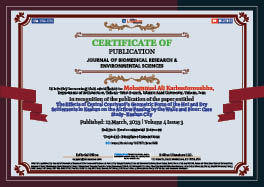Mohammad Ali Karbasforoushha*, Fereshteh Habib and Hossein Zabihi
Volume4-Issue3
Dates: Received: 2023-01-26 | Accepted: 2023-03-10 | Published: 2023-03-12
Pages: 394-400
Abstract
One way to achieve high energy efficiency in buildings and a reliable architectural system is to use the experiences of local architecture. In this connection, the central courtyard is an element that was used in the past to create comfort in the hot and dry climates of Kashan, Iran. A large part of the literature in the past has focused on this space and investigated factors such as height, length, and presence of water in the courtyard, which are directly related to the studied space. This study addresses the dynamic behavior of air in the courtyard under the effects of its geometric form and the airflow passing by its walls and floor to ventilate the space, aiming to increase efficiency. The Energy Plus analyzes this component, and Open Studio software and the research uses the descriptive-analytical method to investigate the findings. It is concluded that air circulation is best met by an airflow loop inside the courtyard in the central courtyard and it was ultimately revealed that the central courtyard priority per the geometric form is the oval with rectangular being the next. The circular, hexagonal and trapezoidal shapes of the yard have been shown to understand better the movement of the wind adjacent to the bottom of the yard (south-to-north) and the flow of the upper layer (north-to-south).
FullText HTML
FullText PDF
DOI: 10.37871/jbres1688
Certificate of Publication

Copyright
© 2023 Karbasforoushha MA, et al. Distributed under Creative Commons CC-BY 4.0
How to cite this article
Karbasforoushha MA, Habib F, Zabihi H. The Effects of Central Courtyard’s Geometric Form of the Hot and Dry Settlements in Kashan on the Airfl ow Passing by the Walls and Floor: Case Study-Kashan City. 2023 Mar 12; 4(3): 394-400. doi: 10.37871/jbres1688, Article ID: JBRES1688, Available at: https://www.jelsciences.com/articles/jbres1688.pdf
Subject area(s)
References
- Gholinejadyasuri KH, Shemirani SM. Sustainability criteria set for the formation of structure and architectural elements of hot and dry climate. Journal of Islamic Art Studies. 2019;15(33).
- Belilan L, Itsam I, Eslami SG. Role of intermediate space to determining the spatial scope of historical contexts. City Identity Journal. 2019;5(8).
- Roza V, Fatemeh MS, Shemirani SM. Principles of passive cooling systems in vernacular architectural elements of Iran. Iran Architect Urban. 2013;(5):147â€159.
- Prelgauskas E. Enhanced natural ventilation in hot arid lands. Australia: The Royal Australian Institute of Architects. 2003.
- Hossein SRM, Mehdi TS. Determination of thermal comfort limits under dry climatic conditions: Case study of Yazd city. Journal of City Identity. 2009;3(4):39-46.
- Hajian M, Tajer SA, Mahdavinejad MJ. Impacts of the courtyard in forming the configuration of traditional Iranian houses in Kashan. Arman Shahr Architecture and Urban Planning. 2020;13(30):43-55.
- Hanif E. The concept of habitation and its effect on the courtyards of Iranian houses: A case study of the Kashan houses of the Qajar period. Architectural Thought. 2017;2(4):31-44.
- Jafarian S, Prapari DM. The effect of the central courtyard pattern in adjusting the hot and dry climate conditions of the houses of Kashan (case example: the houses of Tabatabais and Boroujerdis). Journal of Architecture. 2021;4(18).
- Khaksafidi S, Wathiq B, Taban M. Optimum design of the central courtyard in residential buildings against the 120-day Zabul wind based on CFD analysis. Journal of Spatial Analysis of Environmental Hazards. 2019;7(1):197-212.
- Mazaheri M, Dezhdar O, Mousavi S. Analysis of the role of the yard in the spatial structure of Iranian houses using the space syntax method. Hoviat Shahr Magazine. 2017;12(34):97-108.
- Zarei M, Mirdehghan F. The role of the central courtyard pattern in adjusting the harsh conditions of the hot and dry climate of Yazd region. Irani Islamic Shahr Journal. 2015;6(23):5-18.
- Bently Y, Alen A, Pall M. Soomk G. Responsible environment guideline for designer. Science and Technology University. 2003.
- Soltanzadeh H. Role of geography in forming the types of courtyards in Iranian traditional homes. Geographical Research. 2011;43(75):69-85.
- Mehdi SF, Hamid A, Salva F, Akhtarkavan M, Moradi AM. Review of the interaction between the principles of Iranian architecture and solar energy from the perspective of form, symmetry and direction (Case study: Kashan Abbasian House). Arman Shahr Architecture and Urban Development. 2013;5(11):75-90.
- Kristianto M, Utama NA, Fathoni AM. Analyzing indoor environment of Minahasa traditional house using CFD. Procedia Environmental Sciences. 2014;20;172-179. doi: 10.1016/j.proenv.2014.03.023.
- Bayat Z, Khodakarmi J, Nasrallahi N, Nasrallahi F. Review of the impacts of climatic elements on the Kashan's architecture of central courtyard houses. Second National Conference on Climate and Energy Consumption Optimization. 2014.
- Nejad MB, Arabi AH. Recognition of central courtyard space in hot and dry climates. The First National Conference on Geography. Urban Planning and Sustainable Development. 2013.
- Kateb F. Iranian house architecture. Ministry of Culture and Islamic Guidance. Printing and Publication Organization. 2005.
- Motazedian A. Outdoor comfort. M.A. in Landscape Architecture. Shahid Beheshti Faculty of Architecture and Urban Development. 2010.
- Bukharaei S. Principles of ecological design of historical-cultural axes in hot and dry climate (case study: Kohandej of Semnan). M.A. in Architecture. Faculty of Architecture and Urban Development. Shahid Beheshti. Tehran. 2010.
- Forghani D. Study of the principles of landscaping in Kashan's courtyards. M.A. in Landscape Architecture. Shahid Beheshti School of Architecture and Urban Development. Tehran. 2011.
- Tabesh T, Sertyesilisik B. An investigation on energy efficient courtyard design criteria. International Conference on Chemical, Civil and Environmental Engineering (CCEE-2015). 2015.
- Muhaisen AS. Shading simulation of the courtyard form in different climatic regions. Building and Environment. 2006;41:1731-1741.